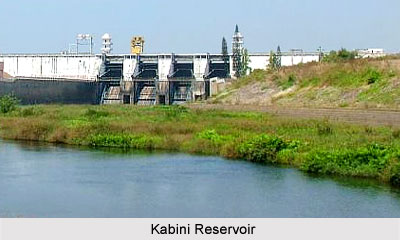 The Kabini Reservoir is located in the Indian state of Karnataka. More specifically, this reservoir is situated across River Kabini near Bidarahally and Beechana halli in Heggadadevanakote Taluk, Mysore District, with canals on both the banks. Globally, Kabini Reservoir can be pinpointed at co ordinates 11 degrees, 50 minutes, 30 seconds North and 76 degree, 20 minutes, 17 seconds East.
The Kabini Reservoir is located in the Indian state of Karnataka. More specifically, this reservoir is situated across River Kabini near Bidarahally and Beechana halli in Heggadadevanakote Taluk, Mysore District, with canals on both the banks. Globally, Kabini Reservoir can be pinpointed at co ordinates 11 degrees, 50 minutes, 30 seconds North and 76 degree, 20 minutes, 17 seconds East.
Formation of Kabini Reservoir
River Kabini originates in the Wayanad District of Kerala, due to the confluence of the Panamaram River and the Mananthavady River. It journeys eastward to meet the Kaveri River at Tirumakudalu Narasipura in Karnataka. This river then amalgamates with the Bay of Bengal. Close to the town of H D Kote, it forms the huge Kabini Reservoir.
Features of Kabini Reservoir
The Gross Storage Capacity (MCM) of Kabini Reservoir is 552.63. Its Live Storage Capacity (MCM) is about 443.63 and the Dead Storage Capacity (MCM) is about 99.675. It"s Submergence Area (Th.Ha.) is about 6.403 and the Catchment Area (Sq.Km.) is about 2142. This Reservoir reaches full Level (m) at 696.16. The Maximum Water Level (m) in the reservoir is about 696.16 while it"s Minimum Draw Down Level (m) is 690.68.The Basin of the Kabini Reservoir is Cauvery.
Wildlife Sanctuaries in the Vicinity of Kabini Reservoir
Kabini Reservoir separates the two parks namely, the Nagarhole National Park and the Bandipur National Park. Thus, these two national parks are located in the vicinity of Kabini Reservoir. The backwater of the Kabini reservoir is very rich in wildlife especially in summer. This is the time when the water level recedes to form rich grassy meadows.
This article is a stub. You can enrich by adding more information to it. Send your Write Up to content@indianetzone.com
Related Articles:
Dams in India
Dams in Karnataka
Balimela Reservoir
Dindi Reservoir
Tatipudi Reservoir
Gandipalem Reservoir
Shriram Sagar Reservoir
Gobind Sagar
Maharana Pratap Sagar Reservoir















